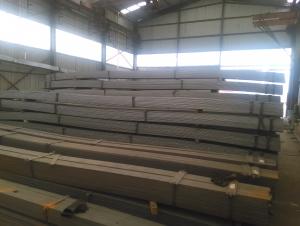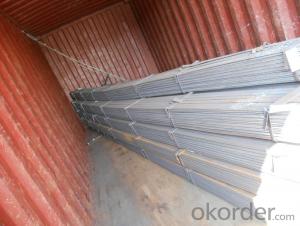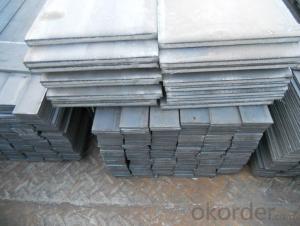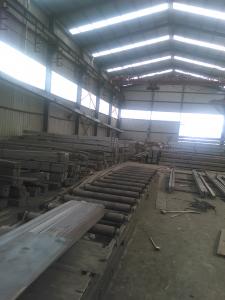Steel Flat Bars with Quality ASTM A36 SS400 or Equivalent
- Loading Port:
- Tianjin
- Payment Terms:
- TT or LC
- Min Order Qty:
- 50 m.t.
- Supply Capability:
- 10000T m.t./month
OKorder Service Pledge
OKorder Financial Service
You Might Also Like
Product Description:
OKorder is offering Steel Flat Bars with Quality ASTM A36 SS400 or Equivalent at great prices with worldwide shipping. Our supplier is a world-class manufacturer of steel, with our products utilized the world over. OKorder annually supplies products to African, South American and Asian markets. We provide quotations within 24 hours of receiving an inquiry and guarantee competitive prices.
Product Applications:
Steel Flat Bars with Quality ASTM A36 SS400 or Equivalent are ideal for structural applications and are widely used in the construction of buildings and bridges, and the manufacturing, petrochemical, and transportation industries.
Product Advantages:
OKorder's Steel Flat Bars with Quality ASTM A36 SS400 or Equivalent are durable, strong, and wide variety of sizes.
Main Product Features:
· Premium quality
· Prompt delivery & seaworthy packing (30 days after receiving deposit)
· Can be recycled and reused
· Mill test certification
· Professional Service
· Competitive pricing
Product Specifications:
Manufacture: slited
Slitting precision (width) : 0.5 mm or less
Raw material: Q235B, Q345B, Q235-1 b
crosscutting precision (length) : 2 mm or less
Processing: the thickness of 2.0-16 mm;
Shear length: 2000 mm above
Wide degree: 15-1250 - mm;
Leveling precision: 1-2 MM square
Packaging: Export packing, nude packing, bundled
FAQ:
Q1: How many tons of steel products could be loaded in containers?
A1: Usually the steel products are delivered by bulk vessel because of the large quantity and the freight. However, there are no bulk vessel enter some seaports so that we have to deliver the cargo by containers. The 6m steel product can be loaded in 20FT container, but the quantity is changed according to the size, usually from 18tons to 25tons.
Q2: How do we guarantee the quality of our products?
A2: We have established an advanced quality management system which conducts strict quality tests at every step, from raw materials to the final product. At the same time, we provide extensive follow-up service assurances as required.
Q3: what is the difference between actual weight and theoretical weight?
A3: All the section steel has two weights: actual weight and theoretical weight. Actual weight is the weighing out when the product delivered from the mill. Theoretical weight is calculated by pieces. The invoice can be based on each of them as your request.
Images:
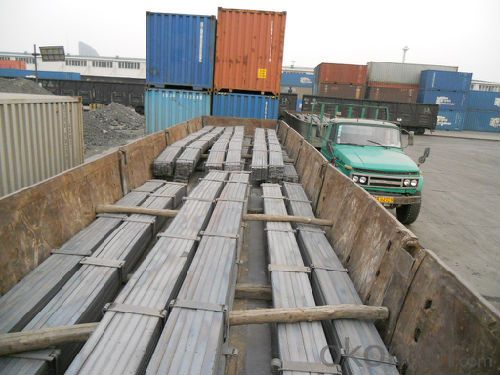
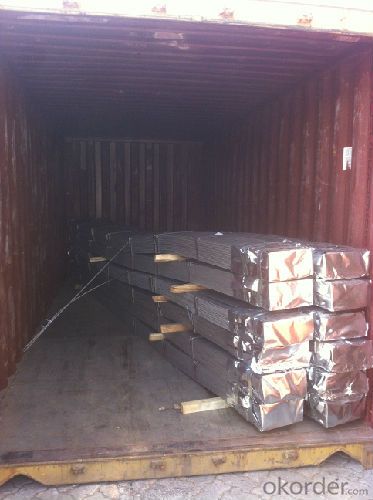
- Q:Can steel flat bars be used for making brackets or supports for electrical installations?
- Yes, steel flat bars can be used for making brackets or supports for electrical installations. Steel is known for its strength, durability, and ability to withstand heavy loads. Steel flat bars are commonly used in construction and engineering projects because of their versatility and reliability. When used for making brackets or supports for electrical installations, steel flat bars can provide a solid and stable structure, ensuring the safety and stability of the electrical components. Additionally, steel is resistant to corrosion, which is crucial in electrical installations where exposure to moisture or harsh environments is a concern. Overall, steel flat bars are a suitable choice for making brackets or supports for electrical installations due to their strength, durability, and resistance to corrosion.
- Q:Can steel flat bars be used for making molds or tooling fixtures?
- Yes, steel flat bars can be used for making molds or tooling fixtures. Steel has excellent strength and durability properties, making it a suitable material for such applications. The flat shape of the bars allows for easy shaping and customization to meet specific mold or fixture requirements. Additionally, steel's resistance to wear and deformation ensures the longevity and reliability of the molds or fixtures.
- Q:How do steel flat bars contribute to the overall stability of a structure?
- The overall stability of a structure is significantly improved with the use of steel flat bars. These bars possess exceptional tensile strength, allowing them to withstand immense forces without bending or breaking. As a result, they provide crucial structural support, preventing the structure from collapsing under heavy loads or external pressures. Furthermore, steel flat bars are commonly employed as braces or reinforcements in construction. They can be strategically positioned and welded to different sections of the structure to enhance its rigidity and prevent any potential deformations. Through the even distribution of weight, these bars play a key role in maintaining the structural integrity and preventing undesirable movements or vibrations. Additionally, steel flat bars exhibit remarkable durability and resistance to corrosion, making them ideal for long-term use in various environments. This durability ensures that the structure remains stable and secure over time, even when exposed to harsh conditions, moisture, or chemicals. Moreover, the versatility of steel flat bars allows for their application in a wide range of structural scenarios. Whether they are used for beams, columns, trusses, or as a foundation for other components, these bars provide stability and support to different parts of the structure. They can be easily customized and fabricated to meet specific design requirements, guaranteeing that the structure is constructed to withstand the intended loads and forces. In conclusion, steel flat bars are essential elements in enhancing the overall stability of a structure. Their exceptional tensile strength, resistance to deformation, durability, and versatility make them indispensable components in construction projects. By offering support, reinforcement, and resistance against external forces, these bars contribute significantly to the structural integrity and safety of the built environment as a whole.
- Q:How do you determine the creep resistance of a steel flat bar?
- The creep resistance of a steel flat bar can be determined by subjecting the material to a constant load or stress for an extended period of time at elevated temperatures. This involves conducting creep tests, where the flat bar is placed in a specialized testing apparatus and exposed to specific temperature and stress conditions. The deformation or strain that occurs over time is then measured, and the creep resistance is determined by analyzing the rate of deformation and the ability of the steel to withstand creep under the given conditions.
- Q:What are the different standards for steel flat bars?
- Steel flat bars, also known as steel flats or flats, are available in a variety of standards that determine their size, shape, and composition. These standards are established to guarantee consistency and excellence in the production and utilization of steel flat bars. One highly recognized standard for steel flat bars is the ASTM A36, which outlines the prerequisites for carbon structural steel. This standard specifies the chemical composition, mechanical properties, and dimensional tolerances for steel flats used in general structural purposes. Another frequently used standard is the ASTM A108, which covers carbon steel bars for general applications. This standard categorizes steel flat bars into different grades based on their chemical composition and mechanical properties. For more specialized applications, there are specific standards tailored to different industries. For example, the ASTM A276 is a standard that pertains to stainless steel bars and shapes. Within this standard, there are specific requirements for stainless steel flat bars, including their chemical composition, mechanical properties, and dimensions. In addition to ASTM standards, there are also international standards that govern the production and use of steel flat bars. The most notable one is the EN 10058, a European standard that specifies the tolerances on dimensions and shape for hot-rolled steel flat bars. Moreover, there are regional or national standards that may apply in certain countries. For instance, the JIS G3194 is a Japanese industrial standard that provides specifications for hot-rolled steel flat bars used in general structures. These standards are crucial to ensure the quality, compatibility, and interchangeability of steel flat bars in different applications. Manufacturers, engineers, and users rely on these standards to choose and work with steel flat bars that meet their specific requirements and adhere to industry norms.
- Q:Are steel flat bars suitable for the construction of walkways or catwalks?
- Yes, steel flat bars are suitable for the construction of walkways or catwalks. Steel flat bars are known for their strength, durability, and versatility, making them an ideal choice for such applications. They provide a sturdy and reliable surface for walking, capable of withstanding heavy loads and high foot traffic. Additionally, steel flat bars can be easily fabricated, cut, and welded to meet specific design requirements, allowing for customization and flexibility in construction projects. Their resistance to corrosion and weathering also ensures that walkways or catwalks made from steel flat bars will have a longer lifespan and require minimal maintenance. Overall, steel flat bars are a popular and widely used material for constructing walkways or catwalks due to their strength, durability, and adaptability.
- Q:What are the different joining methods for steel flat bars?
- When it comes to joining steel flat bars, there are various methods available, depending on the specific application and desired outcome. Some commonly used methods include welding, bolting, riveting, and adhesive bonding. 1. Welding, a versatile and widely used method, involves heating the surfaces of the bars until they melt and then fusing them together using a filler material. This creates a strong and permanent bond between the flat bars. 2. Bolting is a simple yet effective method that uses bolts and nuts to join steel flat bars. It allows for easy disassembly and reassembly if needed, providing a strong and rigid connection suitable for applications requiring frequent assembly and disassembly. 3. Riveting is a mechanical joining method that entails drilling holes in the bars and using rivets to secure the connection. It offers a robust and durable joint, making it suitable for applications requiring high strength and resistance to vibrations. 4. Adhesive bonding involves using industrial adhesives to join steel flat bars. This method is flexible, allowing for the bonding of different materials, and ensures uniform stress distribution. It also provides good resistance to corrosion, making it suitable for applications where other methods may not be practical or suitable. Each joining method has its advantages and limitations, and the choice depends on factors such as application requirements, material properties, and cost considerations. Selecting the appropriate method is crucial to ensuring a secure and durable connection between steel flat bars.
- Q:Can roof strip be replaced with steel pipe instead of flat steel and round steel? Are there any examples of practical use?
- The steel tube seems to be used only as a lightning rod and must be galvanized steel pipe. As for lightning belts... How expensive ah, it does not say, galvanized steel tube bending with large area, not fixed, and each tube about 2m, every 2m connection also can not afford ah. Feel even if there is excess steel pipe, it is better to buy round steel to cost-effective.
- Q:Can steel flat bars be used for creating supports or brackets?
- Yes, steel flat bars can be used for creating supports or brackets. Steel flat bars are commonly used for their strength and durability, making them ideal for supporting heavy loads or providing structural stability. They can be easily shaped or welded to create custom brackets or supports for various applications, such as shelves, furniture, machinery, or construction projects. Steel flat bars are available in different sizes and thicknesses, allowing for versatility in design and application.
- Q:Can steel flat bars be used for machinery or equipment?
- Indeed, machinery or equipment can utilize steel flat bars. Steel, an adaptable and long-lasting substance, finds extensive employment across diverse sectors such as manufacturing and construction. The sturdiness, inflexibility, and capacity to resist deformation of steel flat bars render them a popular choice for constructing machinery and equipment. These bars can be customized, welded, and machined to meet precise specifications, making them suitable for an extensive array of uses. Furthermore, steel flat bars exhibit the capability to endure significant burdens, making them exceptionally suitable for bolstering and reinforcing machinery and equipment.
1. Manufacturer Overview |
|
|---|---|
| Location | |
| Year Established | |
| Annual Output Value | |
| Main Markets | |
| Company Certifications | |
2. Manufacturer Certificates |
|
|---|---|
| a) Certification Name | |
| Range | |
| Reference | |
| Validity Period | |
3. Manufacturer Capability |
|
|---|---|
| a)Trade Capacity | |
| Nearest Port | |
| Export Percentage | |
| No.of Employees in Trade Department | |
| Language Spoken: | |
| b)Factory Information | |
| Factory Size: | |
| No. of Production Lines | |
| Contract Manufacturing | |
| Product Price Range | |
Send your message to us
Steel Flat Bars with Quality ASTM A36 SS400 or Equivalent
- Loading Port:
- Tianjin
- Payment Terms:
- TT or LC
- Min Order Qty:
- 50 m.t.
- Supply Capability:
- 10000T m.t./month
OKorder Service Pledge
OKorder Financial Service
Similar products
New products
Hot products
Related keywords
